anton lundkvist
New member
- Joined
- Jun 24, 2009
- Messages
- 4
- Reaction score
- 22
- Website
- www.al-safari.blogspot.com
- Media
- 40
- Articles
- 1
- Member of
- CAWA Safari Central African Republic
In the tracks of the Central African Savanna Buffalo
I don't think I've ever heard a hunter say he doesn't like buffalo hunting. And for sure; There's something special about it!
It's often the first real big game that first time Africa hunters go after. Many of those hunters get really hooked on it; the adrenalin and intensity in buffalo hunting is often the reason.
As many of you know there are several subspecies of buffalo in Africa, among which the Cape buffalo is probably the most well known. I'm not going to sort all the classifications out, but concentrate on the very interesting subspecies called Central African Savanna Buffalo. (SCI classification)
The two subspecies in CAR
Within CAR there are two main types of buffalo; the dwarf buffalo (S. caffer nanus) living in the dense rain forest in the southern part of the country, and the Central African savanna buffalo referred to as (S. caffer aequinoctialis), living in a mixed biotop of savanna and rain forest in the rest of the country.
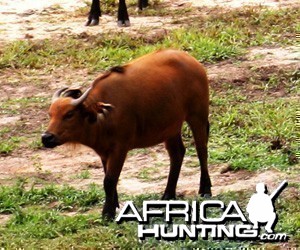
Young forest buffalo. Typical red color, back sweep and no spread.
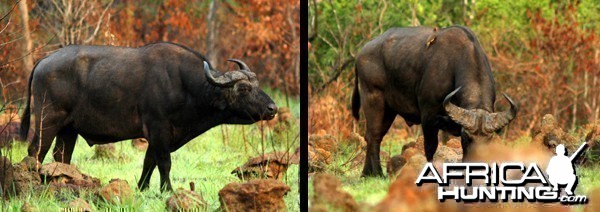
A Central African Savanna buffalo as most people would describe it, nice back sweep but still with a good spread and black-reddish color.
An interesting mix
So what's so interesting about the Central African Savanna Buffalo then? Well the interesting thing is that it's actually a mix of all types of buffalos; Dwarf buffalo, Nile Buffalo, Western Buffalo and in eastern CAR there even seem to be Cape buffalo genes in the herds. All these subspecies meet and mix in Central African Republic, and a hunter going there for buffalo hunting might therefore come home with a very interesting set of buffalo trophies to put in the trophy room.
In the same herd of buffalos you can find small or big reddish bulls with back sweeping horns and also big black or red ones with a good spread on the horns. In eastern CAR there are also bulls with a very deep curl which reminds very much of the Cape buffalo. The color doesn't seem to have any connection with horn or body size, the mix between the different types seems to be totally random.
They all seem to have adapted to the same type of habitat. One would be tempted to believe that the smaller red ones would prefer denser cover, since they must have more dwarf buffalo genes in them, but this doesn't seem to be the case. They thrive even in the more open areas.
And on the other hand the bigger buffalos with a wider spread on the horns don't seem to mind wandering around in the thick rain forest galleries (called "Bako") that are common throughout Central African Republic.
Examples
So let's have a look at these mixes between the different types of buffalos. The following buffalos were all shot in the same hunting area (CAWA Safari concession) this year 2009, in Central African Republic, not far from each other. The biotop is the same over the whole area; a mix of dry bush savanna and tree savanna intersected with small rain forest galleries around the water streams (Bakos).
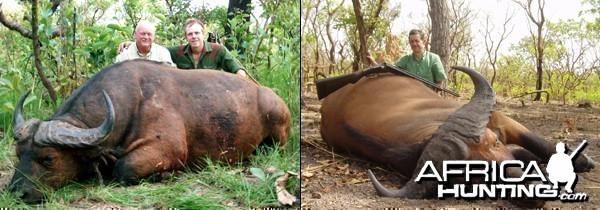
This shows very old and big-bodied red bulls. They both had a very nice and wide spread and massive bosses.

This shows a very old small-bodied red bull. Horns had no spread but a nice back sweep. Note the light color and the long tufts on the ears, typical for dwarf buffalos.

This photo shows a very big black bull with an exceptional spread. This particular one was No 5 SCI.
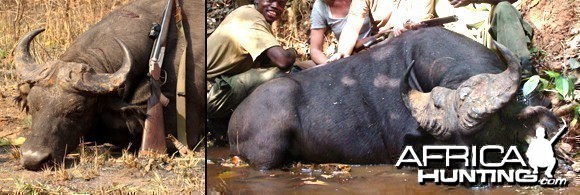
These two old bulls have all the features of a dwarf buffalo, (small body, no spread, nice back sweep etc.), but with the color of a savanna buffalo.
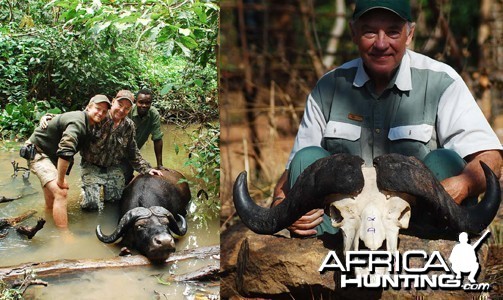
This bull has a clear Cape buffalo-look. Deep curls and massive bosses and nearly no back sweep, but with the body size of a dwarf buffalo.
Classification for mesuring and trophybook registration
When it comes to classification of these buffalos, things can get quite tricky. Should some of these buffalos be considered as Dwarf buffalos or just as small Savanna Buffalos? When it comes to record book registration and measuring, buffalos are mostly classified after the geographical area where they were shot, which in this case mean that they belong to the Central African Savanna Buffalo subspecies. But this method is not always reliable, especially not in these cases where subspecies mix together. It's often up to the measurer and the hunter to determine.
Well, for sure is that in most cases the hunter can go home with a very interesting set of trophies. The possibility of getting both a red and a black buffalo in the same safari is quite unique for Central African Republic. But which one is the most beautiful? Well that's definitely in the eye of the beholder!
I hope to see you there next time, in the tracks of the Central African Buffalo.
Regards,
Anton Lundkvist
//Do not hesitate to give me feedback on the article//
I don't think I've ever heard a hunter say he doesn't like buffalo hunting. And for sure; There's something special about it!
It's often the first real big game that first time Africa hunters go after. Many of those hunters get really hooked on it; the adrenalin and intensity in buffalo hunting is often the reason.
As many of you know there are several subspecies of buffalo in Africa, among which the Cape buffalo is probably the most well known. I'm not going to sort all the classifications out, but concentrate on the very interesting subspecies called Central African Savanna Buffalo. (SCI classification)
The two subspecies in CAR
Within CAR there are two main types of buffalo; the dwarf buffalo (S. caffer nanus) living in the dense rain forest in the southern part of the country, and the Central African savanna buffalo referred to as (S. caffer aequinoctialis), living in a mixed biotop of savanna and rain forest in the rest of the country.
Young forest buffalo. Typical red color, back sweep and no spread.
A Central African Savanna buffalo as most people would describe it, nice back sweep but still with a good spread and black-reddish color.
An interesting mix
So what's so interesting about the Central African Savanna Buffalo then? Well the interesting thing is that it's actually a mix of all types of buffalos; Dwarf buffalo, Nile Buffalo, Western Buffalo and in eastern CAR there even seem to be Cape buffalo genes in the herds. All these subspecies meet and mix in Central African Republic, and a hunter going there for buffalo hunting might therefore come home with a very interesting set of buffalo trophies to put in the trophy room.
In the same herd of buffalos you can find small or big reddish bulls with back sweeping horns and also big black or red ones with a good spread on the horns. In eastern CAR there are also bulls with a very deep curl which reminds very much of the Cape buffalo. The color doesn't seem to have any connection with horn or body size, the mix between the different types seems to be totally random.
They all seem to have adapted to the same type of habitat. One would be tempted to believe that the smaller red ones would prefer denser cover, since they must have more dwarf buffalo genes in them, but this doesn't seem to be the case. They thrive even in the more open areas.
And on the other hand the bigger buffalos with a wider spread on the horns don't seem to mind wandering around in the thick rain forest galleries (called "Bako") that are common throughout Central African Republic.
Examples
So let's have a look at these mixes between the different types of buffalos. The following buffalos were all shot in the same hunting area (CAWA Safari concession) this year 2009, in Central African Republic, not far from each other. The biotop is the same over the whole area; a mix of dry bush savanna and tree savanna intersected with small rain forest galleries around the water streams (Bakos).
This shows very old and big-bodied red bulls. They both had a very nice and wide spread and massive bosses.
This shows a very old small-bodied red bull. Horns had no spread but a nice back sweep. Note the light color and the long tufts on the ears, typical for dwarf buffalos.
This photo shows a very big black bull with an exceptional spread. This particular one was No 5 SCI.
These two old bulls have all the features of a dwarf buffalo, (small body, no spread, nice back sweep etc.), but with the color of a savanna buffalo.
This bull has a clear Cape buffalo-look. Deep curls and massive bosses and nearly no back sweep, but with the body size of a dwarf buffalo.
Classification for mesuring and trophybook registration
When it comes to classification of these buffalos, things can get quite tricky. Should some of these buffalos be considered as Dwarf buffalos or just as small Savanna Buffalos? When it comes to record book registration and measuring, buffalos are mostly classified after the geographical area where they were shot, which in this case mean that they belong to the Central African Savanna Buffalo subspecies. But this method is not always reliable, especially not in these cases where subspecies mix together. It's often up to the measurer and the hunter to determine.
Well, for sure is that in most cases the hunter can go home with a very interesting set of trophies. The possibility of getting both a red and a black buffalo in the same safari is quite unique for Central African Republic. But which one is the most beautiful? Well that's definitely in the eye of the beholder!
I hope to see you there next time, in the tracks of the Central African Buffalo.
Regards,
Anton Lundkvist
//Do not hesitate to give me feedback on the article//
Attachments
-
 Forest buffalo.jpg93.9 KB · Views: 426
Forest buffalo.jpg93.9 KB · Views: 426 -
 big black buffalo.jpg189.3 KB · Views: 473
big black buffalo.jpg189.3 KB · Views: 473 -
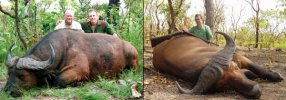 Big Red buffalo 4.jpg223.8 KB · Views: 495
Big Red buffalo 4.jpg223.8 KB · Views: 495 -
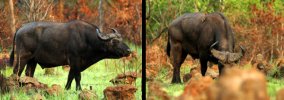 savanna buffalo 2.jpg201 KB · Views: 516
savanna buffalo 2.jpg201 KB · Views: 516 -
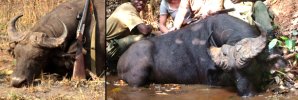 small black buffalo.jpg201 KB · Views: 442
small black buffalo.jpg201 KB · Views: 442 -
 Small cape buffalo.jpg228.2 KB · Views: 452
Small cape buffalo.jpg228.2 KB · Views: 452 -
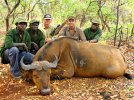 Small red buffalo 1.jpg160.2 KB · Views: 402
Small red buffalo 1.jpg160.2 KB · Views: 402
Last edited by a moderator:

